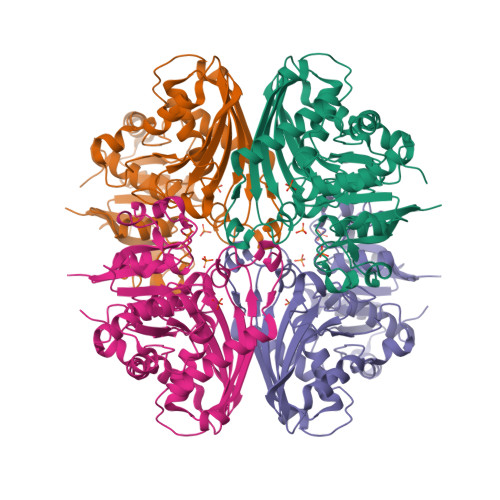Structural Basis for a Bispecific NADP+ and CoA Binding Site in an Archaeal Malonyl-Coenzyme A Reductase.
Demmer, U., Warkentin, E., Srivastava, A., Kockelkorn, D., Potter, M., Marx, A., Fuchs, G., Ermler, U.(2013) J Biological Chem 288: 6363-6370
- PubMed: 23325803
- DOI: https://doi.org/10.1074/jbc.M112.421263
- Primary Citation of Related Structures:
4DPK, 4DPL, 4DPM - PubMed Abstract:
Autotrophic members of the Sulfolobales (crenarchaeota) use the 3-hydroxypropionate/4-hydroxybutyrate cycle to assimilate CO2 into cell material. The product of the initial acetyl-CoA carboxylation with CO2, malonyl-CoA, is further reduced to malonic semialdehyde by an NADPH-dependent malonyl-CoA reductase (MCR); the enzyme also catalyzes the reduction of succinyl-CoA to succinic semialdehyde onwards in the cycle. Here, we present the crystal structure of Sulfolobus tokodaii malonyl-CoA reductase in the substrate-free state and in complex with NADP(+) and CoA. Structural analysis revealed an unexpected reaction cycle in which NADP(+) and CoA successively occupy identical binding sites. Both coenzymes are pressed into an S-shaped, nearly superimposable structure imposed by a fixed and preformed binding site. The template-governed cofactor shaping implicates the same binding site for the 3'- and 2'-ribose phosphate group of CoA and NADP(+), respectively, but a different one for the common ADP part: the β-phosphate of CoA aligns with the α-phosphate of NADP(+). Evolution from an NADP(+) to a bispecific NADP(+) and CoA binding site involves many amino acid exchanges within a complex process by which constraints of the CoA structure also influence NADP(+) binding. Based on the paralogous aspartate-β-semialdehyde dehydrogenase structurally characterized with a covalent Cys-aspartyl adduct, a malonyl/succinyl group can be reliably modeled into MCR and discussed regarding its binding mode, the malonyl/succinyl specificity, and the catalyzed reaction. The modified polypeptide surrounding around the absent ammonium group in malonate/succinate compared with aspartate provides the structural basis for engineering a methylmalonyl-CoA reductase applied for biotechnical polyester building block synthesis.
Organizational Affiliation:
Max-Planck-Institut für Biophysik, D-60438 Frankfurt am Main, Germany.

















